Development of Bio-Composites with Enhanced Antioxidant Activity Based on Poly(lactic acid) with Thymol, Carvacrol, Limonene, or Cinnamaldehyde for Active Food Packaging
Abstract
:1. Introduction
2. Materials and Methods
2.1. Materials
2.2. Experimental Procedure
2.3. Quantification of the Active Ingredients in the PLA Matrix
2.4. Analytical Techniques
2.5. Mathematical Modeling of the Release Rate Profiles
3. Results
3.1. Quantification of the Active Ingredinets in the PLA Matrix and Characterization of the Chemical Structure of the Composites Prepared
3.2. Thermal Properties
3.3. Release Profiles of the Active Compounds from the Polymer Matrix and Study of the Process Kinetics
- Samples are considered isotropic of similar shape and with equal initial active compound concentration.
- The effective diffusion coefficient through the samples is constant.
- There is no resistance to the mass transfer of the active compound from the external surfaces of the samples.
- The active compound is uniformly distributed in the samples.
3.4. Antioxidant Properties
4. Conclusions
Author Contributions
Funding
Acknowledgments
Conflicts of Interest
References
- Vermeiren, L.; Devlieghere, F.; van Beest, M.; de Kruijf, N.; Debevere, J. Developments in the active packaging of foods. Trends Food Sci. Technol. 1999, 10, 77–86. [Google Scholar] [CrossRef]
- Appendini, P.; Hotchkiss, J.H. Review of antimicrobial food packaging. Innov. Food Sci. Emerg. Technol. 2002, 3, 113–126. [Google Scholar] [CrossRef]
- Suppakul, P.; Miltz, J.; Sonneveld, K.; Bigger, S.W. Active packaging Technologies with an Emphasis on Antimicrobial Packaging and its Applications. J. Food Sci. 2003, 68, 408–420. [Google Scholar] [CrossRef] [Green Version]
- López, P.; Sánchez, C.; Batlle, R.; Nerín, C. Development of Flexible Antimicrobial Films Using Essential Oils as Active Agents. J. Agric. Food Chem. 2007, 55, 8814–8824. [Google Scholar] [CrossRef]
- Persico, P.; Ambrogi, V.; Carfagna, C.; Cerruti, P.; Ferrocino, I.; Mauriello, G. Nanocomposite polymer films containing carvacrol for antimicrobial active packaging. Polym. Eng. Sci. 2009, 49, 1447–1455. [Google Scholar] [CrossRef]
- Valentão, P.; Fernandes, E.; Carvalho, F.; Andrade, P.B.; Seabra, R.M.; Bastos, M.L. Antioxidative Properties of Cardoon (Cynara cardunculus L.) Infusion Against Superoxide Radical, Hydroxyl Radical, and Hypochlorous Acid. J. Agric. Food Chem. 2002, 50, 4989–4993. [Google Scholar] [CrossRef] [PubMed]
- Bakkali, F.; Averbeck, S.; Idaomar, M. Biological effects of essential oils—A review. Food Chem. Toxicol. 2008, 46, 446–475. [Google Scholar] [CrossRef] [PubMed]
- Al-Bandak, G.; Oreopoulou, V. Antioxidant properties and composition of Majorana syriaca extracts. Eur. J. Lipid Sci. Technol. 2007, 109, 247–255. [Google Scholar] [CrossRef]
- Didry, N.; Dubreuil, L.; Pinkas, M. Activity of thymol, carvacrol, cinnamaldehyde and eugenol on oral bacteria. Pharm. Acta Helvetiae 1994, 69, 25–28. [Google Scholar] [CrossRef]
- Veldhuizen, E.J.A.; Bokhoven, J.L.M.T.-V.; Zweijtzer, C.; Burt, S.A.; Haagsman, H.P. Structural Requirements for the Antimicrobial Activity of Carvacrol. J. Agric. Food Chem. 2006, 54, 1874–1879. [Google Scholar] [CrossRef] [PubMed]
- Youdim, K.A.; Deans, S.G. Effect of thyme oil and thymol dietary supplementation on the antioxidant status and fatty acid composition of the ageing rat brain. Br. J. Nutr. 2000, 83, 87–93. [Google Scholar] [CrossRef] [Green Version]
- Sanchez-Garcia, M.; Gimenez, E.; Lagaron, J. Morphology and barrier properties of solvent cast composites of thermoplastic biopolymers and purified cellulose fibers. Carbohydr. Polym. 2008, 71, 235–244. [Google Scholar] [CrossRef]
- Halliwell, B.; Aeschbach, R.; Löliger, J.; Aruoma, O.I. The characterization of antioxidants. Food Chem. Toxicol. 1995, 33, 601–617. [Google Scholar] [CrossRef]
- Salafranca, J.; Pezo, D.; Nerín, C. Assessment of specific migration to aqueous simulants of a new active food packaging containing essential oils by means of an automatic multiple dynamic hollow fibre liquid phase microextraction system. J. Chromatogr. A 2009, 1216, 3731–3739. [Google Scholar] [CrossRef] [PubMed]
- Baldim, V.; de Oliveira, M.G. Poly-ε-caprolactone/polysulfhydrylated polyester blend: A platform for topical and degradable nitric oxide-releasing materials. Eur. Polym. J. 2018, 109, 143–152. [Google Scholar] [CrossRef]
- Hu, H.; Zhang, R.; Sousa, A.; Long, Y.; Bin Ying, W.; Wang, J.; Zhu, J. Bio-based poly(butylene 2,5-furandicarboxylate)-b-poly(ethylene glycol) copolymers with adjustable degradation rate and mechanical properties: Synthesis and characterization. Eur. Polym. J. 2018, 106, 42–52. [Google Scholar] [CrossRef]
- Aversa, C.; Barletta, M.; Gisario, A.; Pizzi, E.; Puopolo, M.; Vesco, S. Improvements in mechanical strength and thermal stability of injection and compression molded components based on Poly Lactic Acids. Adv. Polym. Technol. 2017, 37, 2158–2170. [Google Scholar] [CrossRef]
- Dubey, S.P.; Thakur, V.K.; Krishnaswamy, S.; Abhyankar, H.; Marchante, V.; Brighton, J. Progress in environmental-friendly polymer nanocomposite material from PLA: Synthesis, processing and applications. Vacuum 2017, 146, 655–663. [Google Scholar] [CrossRef] [Green Version]
- Youngpreda, A.; Panyachanakul, T.; Kitpreechavanich, V.; Sirisansaneeyakul, S.; Suksamrarn, S.; Tokuyama, S.; Krajangsang, S. Optimization of Poly(dl-Lactic Acid) Degradation and Evaluation of Biological Re-polymerization. J. Polym. Environ. 2016, 25, 1131–1139. [Google Scholar] [CrossRef]
- Cazacu, G.; Darie-Nita, R.N.; Chirila, O.; Totolin, M.; Asandulesa, M.; Ciolacu, D.E.; Ludwiczak, J.; Vasile, C. Environmentally Friendly Polylactic Acid/Modified Lignosulfonate Biocomposites. J. Polym. Environ. 2016, 25, 884–902. [Google Scholar] [CrossRef]
- Basu, A.; Nazarkovsky, M.; Ghadi, R.; Khan, W.; Domb, A.J. Poly(lactic acid)-based nanocomposites. Polym. Adv. Technol. 2017, 28, 919–930. [Google Scholar] [CrossRef]
- Proikakis, C.S.; Mamouzelos, N.J.; Tarantili, P.A.; Andreopoulos, A.G. Swelling and hydrolytic degradation of poly(d,l-lactic acid) in aqueous solutions. Polym. Degrad. Stab. 2006, 91, 614–619. [Google Scholar] [CrossRef]
- Gupta, A.; Kumar, V. New emerging trends in synthetic biodegradable polymers—Polylactide: A critique. Eur. Polym. J. 2007, 43, 4053–4074. [Google Scholar] [CrossRef]
- Maharana, T.; Mohanty, B.; Negi, Y. Melt–solid polycondensation of lactic acid and its biodegradability. Prog. Polym. Sci. 2009, 34, 99–124. [Google Scholar] [CrossRef]
- Taylor, M.S.; Daniels, A.U.; Andriano, K.P.; Heller, J. Six bioabsorbable polymers:In vitro acute toxicity of accumulated degradation products. J. Appl. Biomater. 1994, 5, 151–157. [Google Scholar] [CrossRef]
- Lagaron, J.M.; Cabedo, L.; Cava, D.; Feijoo, J.L.; Gavara, R.; Gimenez, E. Improving packaged food quality and safety. Part 2: Nanocomposites. Food Addit. Contam. 2005, 22, 994–998. [Google Scholar] [CrossRef] [PubMed]
- Chang, J.-H.; An, Y.U.; Cho, D.; Giannelis, E.P. Poly(lactic acid) nanocomposites: Comparison of their properties with montmorillonite and synthetic mica (II). Polymer 2003, 44, 3715–3720. [Google Scholar] [CrossRef]
- Siracusa, V.; Rocculi, P.; Romani, S.; Rosa, M.D. Biodegradable polymers for food packaging: A review. Trends Food Sci. Technol. 2008, 19, 634–643. [Google Scholar] [CrossRef]
- Ramos, M.; Jiménez, A.; Peltzer, M.A.; Garrigós, M.D.C. Development of novel nano-biocomposite antioxidant films based on poly (lactic acid) and thymol for active packaging. Food Chem. 2014, 162, 149–155. [Google Scholar] [CrossRef] [Green Version]
- Ramos, M.; Fortunati, E.; Beltrán, A.; Peltzer, M.; Cristofaro, F.; Visai, L.; Valente, A.J.M.; Jiménez, A.; María Kenny, J.; Carmen Garrigós, M. Controlled release, disintegration, antioxidant, and antimicrobial properties of poly (lactic acid)/thymol/nanoclay composites. Polymers 2020, 12, 1878. [Google Scholar] [CrossRef] [PubMed]
- Stepczynska, M. Influence of active compounds on the degradation of polylactide biocomposites. Polimery 2019, 64, 410–416. [Google Scholar] [CrossRef] [Green Version]
- Dintcheva, N.T.; Baiamonte, M.; Spera, M. Assessment of pro-oxidant activity of natural phenolic compounds in bio-polyesters. Polym. Degrad. Stab. 2018, 152, 280–288. [Google Scholar] [CrossRef]
- Celebi, H.; Gunes, E. Combined effect of a plasticizer and carvacrol and thymol on the mechanical, thermal, morphological properties of poly(lactic acid). J. Appl. Polym. Sci. 2017, 135. [Google Scholar] [CrossRef]
- Tawakkal, I.S.M.A.; Cran, M.J.; Bigger, S.W. Interaction and quantification of thymol in active PLA-based materials containing natural fibers. J. Appl. Polym. Sci. 2015, 133. [Google Scholar] [CrossRef] [Green Version]
- Tawakkal, I.S.; Cran, M.J.; Bigger, S.W. The influence of chemically treated natural fibers in poly(lactic acid) composites containing thymol. Polym. Compos. 2016, 39, 1261–1272. [Google Scholar] [CrossRef] [Green Version]
- Del Nobile, M.; Conte, A.; Buonocore, G.; Incoronato, A.; Massaro, A.; Panza, O. Active packaging by extrusion processing of recyclable and biodegradable polymers. J. Food Eng. 2009, 93, 1–6. [Google Scholar] [CrossRef]
- Altan, A.; Aytac, Z.; Uyar, T. Carvacrol loaded electrospun fibrous films from zein and poly(lactic acid) for active food packaging. Food Hydrocoll. 2018, 81, 48–59. [Google Scholar] [CrossRef] [Green Version]
- Armentano, I.; Fortunati, E.; Burgos, N.; Dominici, F.; Luzi, F.; Fiori, S.; Jiménez, A.; Yoon, K.; Ahn, J.; Kang, S.; et al. Bio-based PLA_PHB plasticized blend films: Processing and structural characterization. LWT 2015, 64, 980–988. [Google Scholar] [CrossRef] [Green Version]
- Scaffaro, R.; Lopresti, F. Processing, structure, property relationships and release kinetics of electrospun PLA/Carvacrol membranes. Eur. Polym. J. 2018, 100, 165–171. [Google Scholar] [CrossRef]
- Scaffaro, R.; Lopresti, F.; D’Arrigo, M.; Marino, A.; Nostro, A. Efficacy of poly(lactic acid)/carvacrol electrospun membranes against Staphylococcus aureus and Candida albicans in single and mixed cultures. Appl. Microbiol. Biotechnol. 2018, 102, 4171–4181. [Google Scholar] [CrossRef]
- Scaffaro, R.; Maio, A.; Nostro, A. Poly(lactic acid)/carvacrol-based materials: Preparation, physicochemical properties, and antimicrobial activity. Appl. Microbiol. Biotechnol. 2020, 104, 1823–1835. [Google Scholar] [CrossRef]
- Yang, C.; Tang, H.; Wang, Y.; Liu, Y.; Wang, J.; Shi, W.; Li, L. Development of PLA-PBSA based biodegradable active film and its application to salmon slices. Food Packag. Shelf Life 2019, 22, 100393. [Google Scholar] [CrossRef]
- Llana-Ruíz-Cabello, M.; Puerto, M.; Pichardo, S.; Jiménez-Morillo, N.; Bermúdez, J.; Aucejo, S.; Camean, A.; González-Pérez, J. Preservation of phytosterol and PUFA during ready-to-eat lettuce shelf-life in active bio-package. Food Packag. Shelf Life 2019, 22, 100410. [Google Scholar] [CrossRef]
- Llana-Ruíz-Cabello, M.; Pichardo, S.; Jiménez-Morillo, N.T.; Bermudez, J.M.; Aucejo, S.; Gonzalez-Vila, F.J.; Cameán, A.M.; González-Pérez, J.A. Molecular characterisation of a bio-based active packaging containing Origanum vulgare L. essential oil using pyrolysis gas chromatography-mass spectrometry. J. Sci. Food Agric. 2015, 96, 3207–3212. [Google Scholar] [CrossRef] [Green Version]
- Wang, L.; Heising, J.; Fogliano, V.; Dekker, M. Fat content and storage conditions are key factors on the partitioning and activity of carvacrol in antimicrobial packaging. Food Packag. Shelf Life 2020, 24, 100500. [Google Scholar] [CrossRef]
- Velázquez-Contreras, F.; García-Caldera, N.; de la Rosa, J.P.; Martínez-Romero, D.; Núñez-Delicado, E.; Gabaldón, J. Effect of PLA Active Packaging Containing Monoterpene-Cyclodextrin Complexes on Berries Preservation. Polymers 2021, 13, 1399. [Google Scholar] [CrossRef]
- Arrieta, M.P.; Lopez, J.; Hernández, A.; Rayón, E. Ternary PLA–PHB–Limonene blends intended for biodegradable food packaging applications. Eur. Polym. J. 2014, 50, 255–270. [Google Scholar] [CrossRef]
- Arrieta, M.P.; Lopez, J.; Ferrandiz, S.; Peltzer, M.A. Characterization of PLA-limonene blends for food packaging applications. Polym. Test. 2013, 32, 760–768. [Google Scholar] [CrossRef]
- Brüster, B.; Adjoua, Y.-O.; Dieden, R.; Grysan, P.; Federico, C.E.; Berthé, V.; Addiego, F. Plasticization of Polylactide with Myrcene and Limonene as Bio-Based Plasticizers: Conventional vs. Reactive Extrusion. Polymers 2019, 11, 1363. [Google Scholar] [CrossRef] [PubMed] [Green Version]
- Fortunati, E.; Luzi, F.; Puglia, D.; Dominici, F.; Santulli, C.; Kenny, J.M.; Torre, L. Investigation of thermo-mechanical, chemical and degradative properties of PLA-limonene films reinforced with cellulose nanocrystals extracted from Phormium tenax leaves. Eur. Polym. J. 2014, 56, 77–91. [Google Scholar] [CrossRef]
- Sangkasanya, S.; Naknaen, P.; Petchwattana, N. Feasibility application of biodegradable active films produced by poly(lactic acid) incorporating with limonene as an antimicrobial packaging for fresh beef meat. In Proceedings of the 8th International Conference on Bioscience, Biochemistry and Bioinformatics, Tokyo, Japan, 18–20 January 2018; pp. 60–64. [Google Scholar] [CrossRef]
- Qin, Y.; Liu, D.; Wu, Y.; Yuan, M.; Li, L.; Yang, J. Effect of PLA/PCL/cinnamaldehyde antimicrobial packaging on physicochemical and microbial quality of button mushroom (Agaricus bisporus). Postharvest Biol. Technol. 2015, 99, 73–79. [Google Scholar] [CrossRef]
- Qin, Y.; Yang, J.; Xue, J. Characterization of antimicrobial poly(lactic acid)/poly(trimethylene carbonate) films with cinnamaldehyde. J. Mater. Sci. 2014, 50, 1150–1158. [Google Scholar] [CrossRef]
- Akgün, M.; Başaran, I.; Suner, S.C.; Oral, A. Geraniol and cinnamaldehyde as natural antibacterial additives for poly(lactic acid) and their plasticizing effects. J. Polym. Eng. 2019, 40, 38–48. [Google Scholar] [CrossRef]
- Zhang, L.; Huang, C.; Xu, Y.; Huang, H.; Zhao, H.; Wang, J.; Wang, S. Synthesis and characterization of antibacterial polylactic acid film incorporated with cinnamaldehyde inclusions for fruit packaging. Int. J. Biol. Macromol. 2020, 164, 4547–4555. [Google Scholar] [CrossRef] [PubMed]
- Muller, J.; González-Martínez, C.; Chiralt, A. Poly(lactic) acid (PLA) and starch bilayer films, containing cinnamaldehyde, obtained by compression moulding. Eur. Polym. J. 2017, 95, 56–70. [Google Scholar] [CrossRef]
- Muller, J.; Quesada, A.C.; González-Martínez, C.; Chiralt, A. Antimicrobial properties and release of cinnamaldehyde in bilayer films based on polylactic acid (PLA) and starch. Eur. Polym. J. 2017, 96, 316–325. [Google Scholar] [CrossRef]
- Sepulveda, J.; Villegas, C.; Torres, A.; Vargas, E.; Rodriguez, F.; Baltazar, S.; Prada, A.; Rojas, A.; Romero, J.; Faba, S.; et al. Effect of functionalized silica nanoparticles on the mass transfer process in active PLA nanocomposite films obtained by supercritical impregnation for sustainable food packaging. J. Supercrit. Fluids 2020, 161, 104844. [Google Scholar] [CrossRef]
- Cui, R.; Jiang, K.; Yuan, M.; Cao, J.; Li, L.; Tang, Z.; Qin, Y. Antimicrobial film based on polylactic acid and carbon nanotube for controlled cinnamaldehyde release. J. Mater. Res. Technol. 2020, 9, 10130–10138. [Google Scholar] [CrossRef]
- Andriotis, E.G.; Papi, R.M.; Paraskevopoulou, A.; Achilias, D.S. Synthesis of D-Limonene Loaded Polymeric Nanoparticles with Enhanced Antimicrobial Properties for Potential Application in Food Packaging. Nanomaterials 2021, 11, 191. [Google Scholar] [CrossRef]
- Tsagkalias, I.S.; Loukidi, A.; Chatzimichailidou, S.; Salmas, C.E.; Giannakas, A.E.; Achilias, D.S. Effect of Na- and Organo-Modified Montmorillonite/Essential Oil Nanohybrids on the Kinetics of the In Situ Radical Polymerization of Styrene. Nanomaterials 2021, 11, 474. [Google Scholar] [CrossRef]
- Sáez-Orviz, S.; Marcet, I.; Weng, S.; Rendueles, M.; Díaz, M. PLA nanoparticles loaded with thymol to improve its incorporation into gelatine films. J. Food Eng. 2019, 269, 109751. [Google Scholar] [CrossRef]
- Ramos, M.; Jiménez, A.; Peltzer, M.A.; Garrigós, M.D.C. Characterization and antimicrobial activity studies of polypropylene films with carvacrol and thymol for active packaging. J. Food Eng. 2011, 109, 513–519. [Google Scholar] [CrossRef]
- Yang, J.; Pan, H.; Li, X.; Sun, S.; Zhang, H.; Dong, L. A study on the mechanical, thermal properties and crystallization behavior of poly(lactic acid)/thermoplastic poly(propylene carbonate) polyurethane blends. RSC Adv. 2017, 7, 46183–46194. [Google Scholar] [CrossRef] [Green Version]
- Inácio, E.M.; Souza, D.H.S.; Dias, M.L. Thermal and Crystallization Behavior of PLA/PLLA-Grafting Cellulose Nanocrystal. Mater. Sci. Appl. 2020, 11, 44–57. [Google Scholar] [CrossRef] [Green Version]
- Fischer, E.W.; Sterzel, H.J.; Wegner, G. Investigation of the structure of solution grown crystals of lactide copolymers by means of chemical reactions. Colloid. Polym. Sci. 1973, 251, 980–990. [Google Scholar]
- Crank, J. The Mathematics of Diffusion, 2nd ed.; Oxford University Press: New York, NY, USA, 1975. [Google Scholar]
- Piringer, O.; Beu, T. Transport Equations and Their Solutions. In Plastic Packaging, 2nd ed.; Piringer, O., Baner, A., Eds.; Wiley-VCH: Weinheim, Germany, 2008; Chapter 7. [Google Scholar]
- Neogi, P. Transport phenomena in polymer membranes. In Diffusion in Polymers; Neogi, P., Ed.; Marcel Dekker, Inc.: New York, NY, USA, 1996; Chapter 4. [Google Scholar]
- Giannakas, A. Na-Montmorillonite vs. Organically Modified Montmorillonite as Essential Oil Nanocarriers for Melt-Extruded Low-Density Poly-Ethylene Nanocomposite Active Packaging Films with a Controllable and Long-Life Antioxidant Activity. Nanomaterials 2020, 10, 1027. [Google Scholar] [CrossRef]
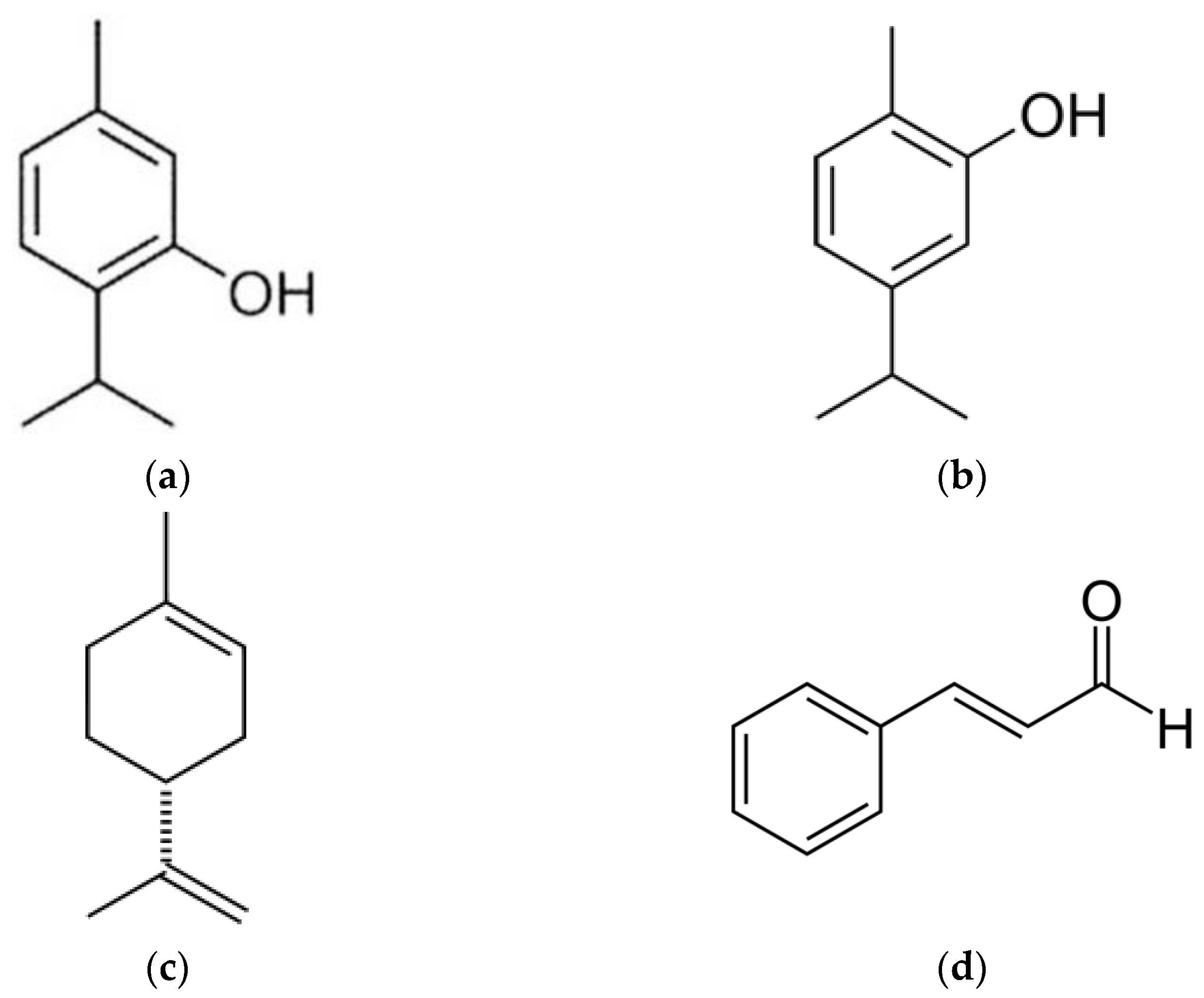

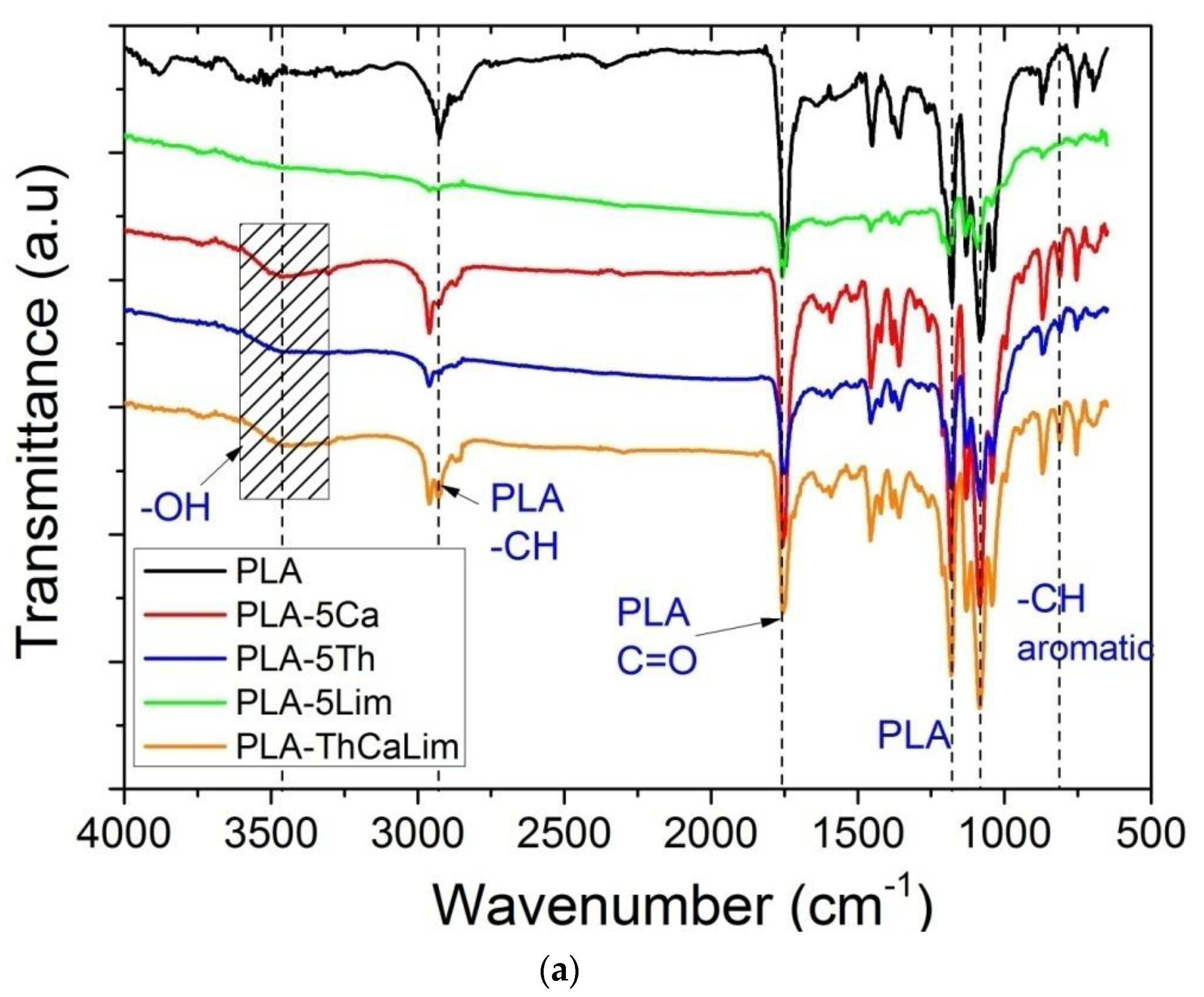
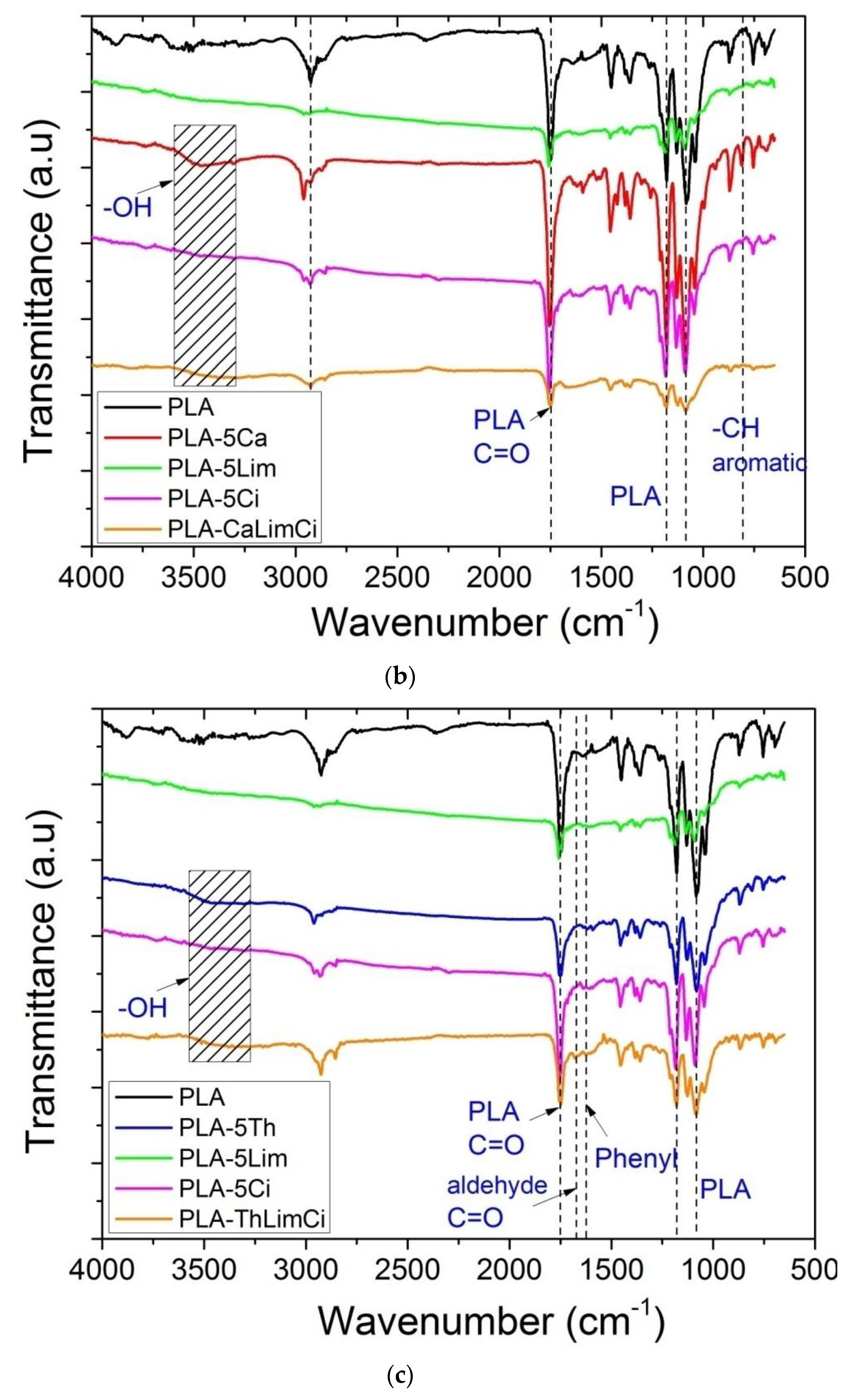

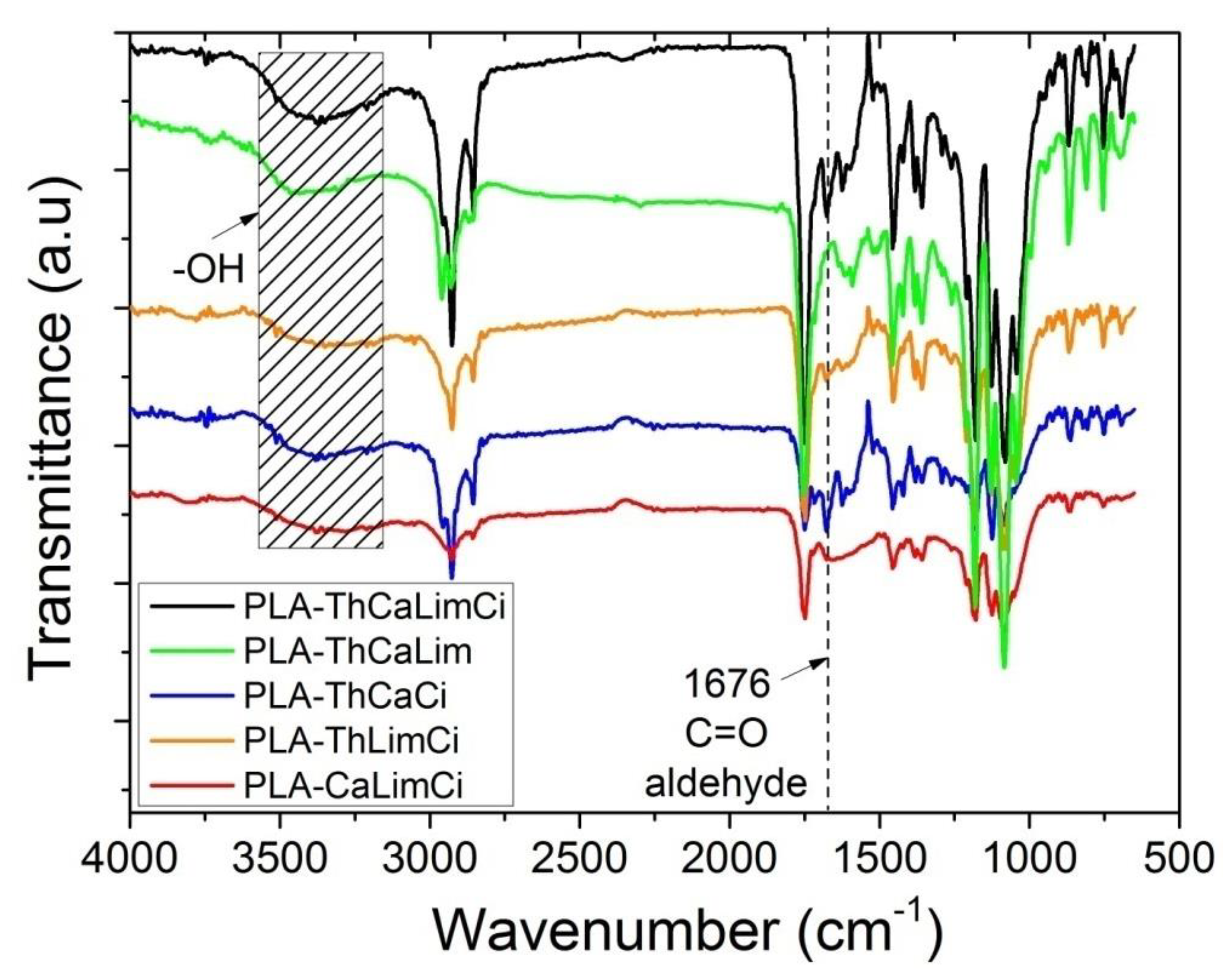
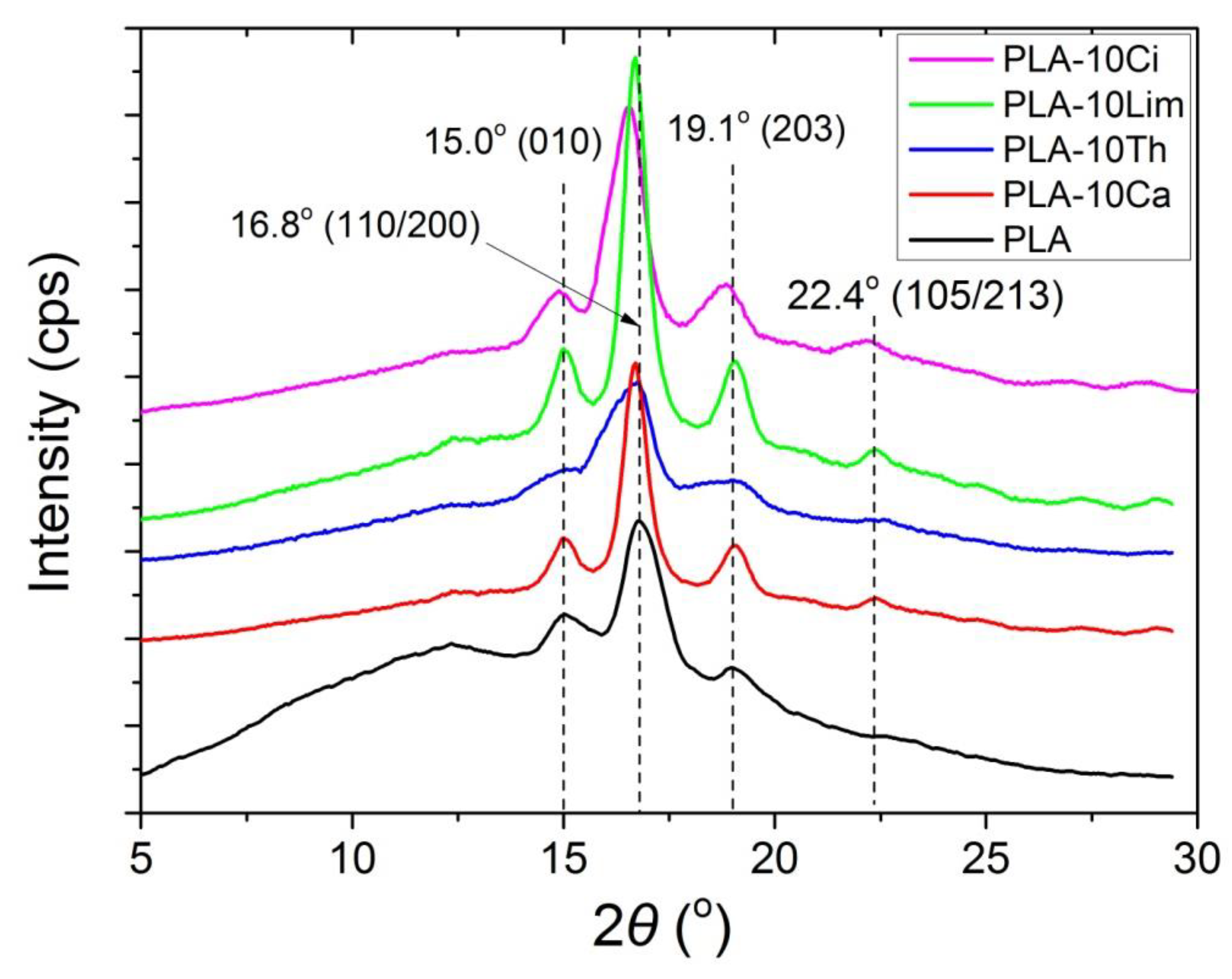
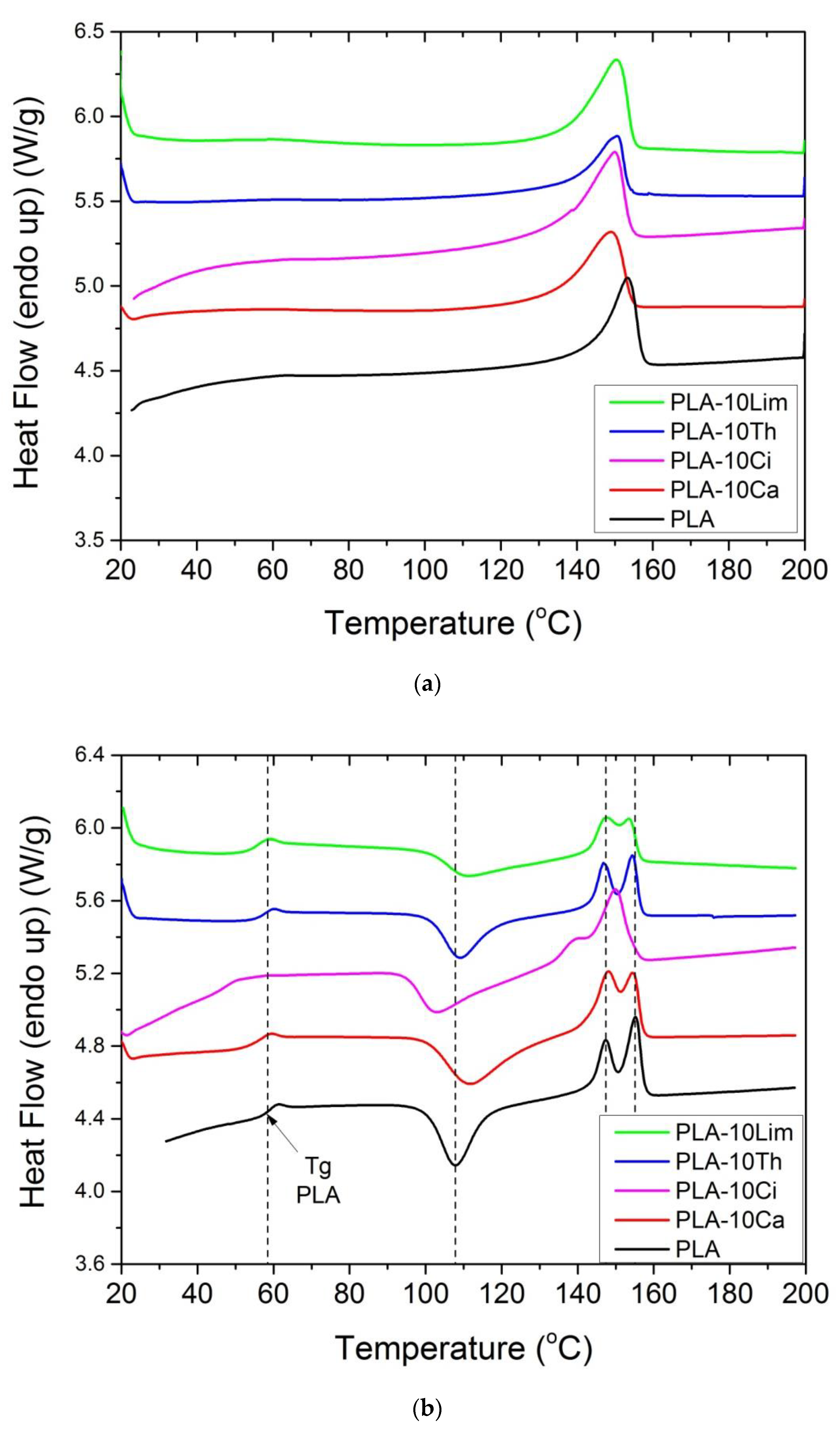
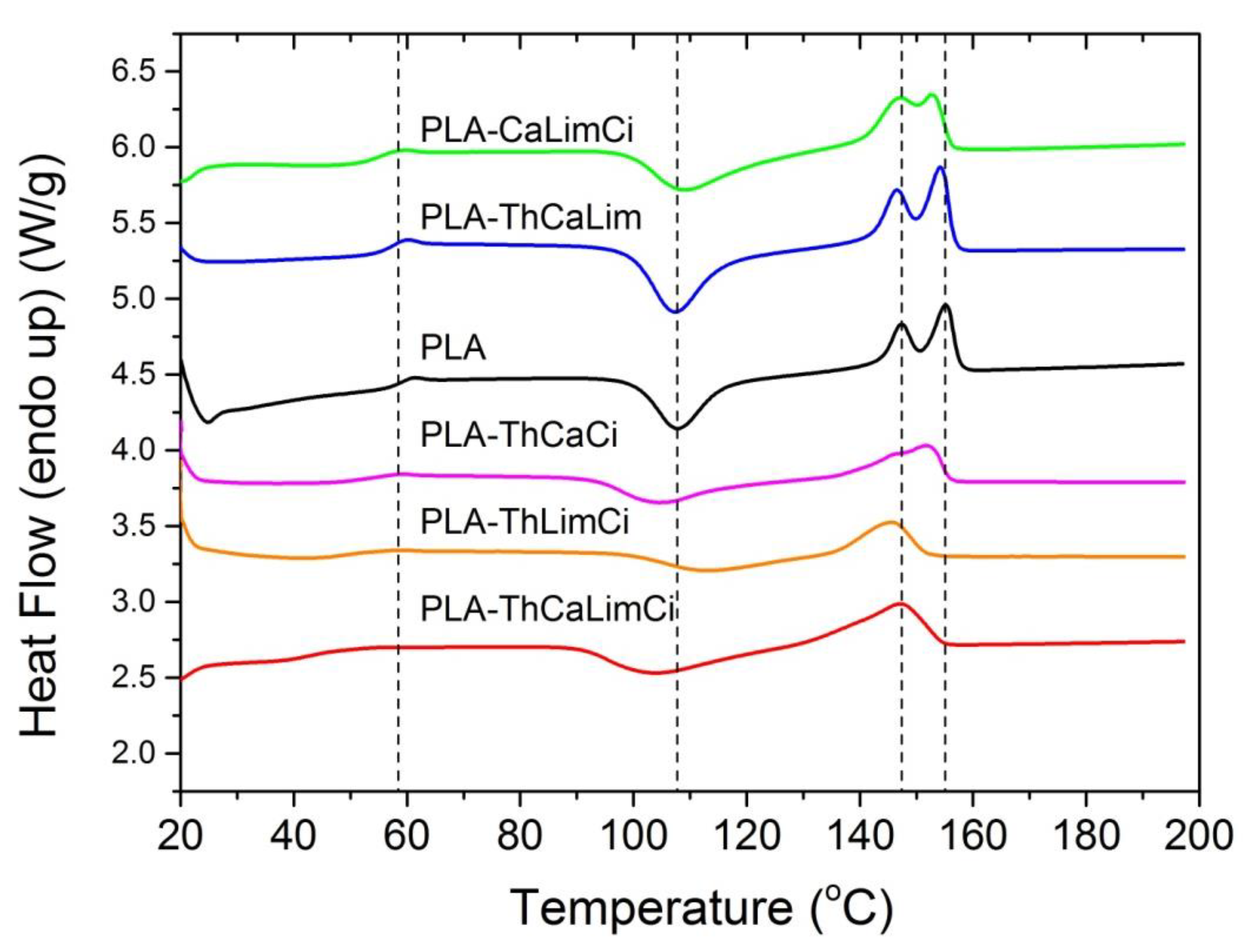
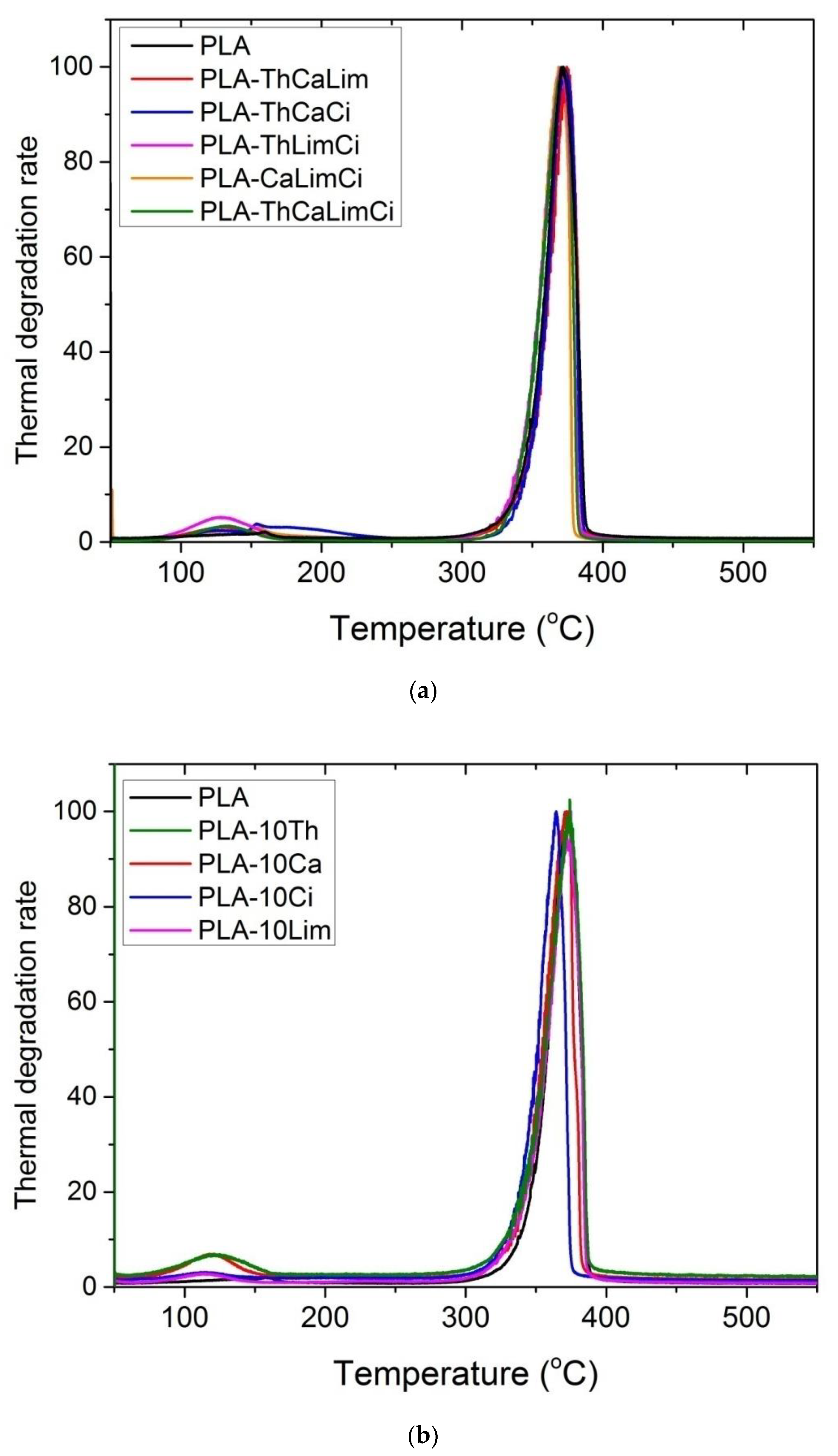
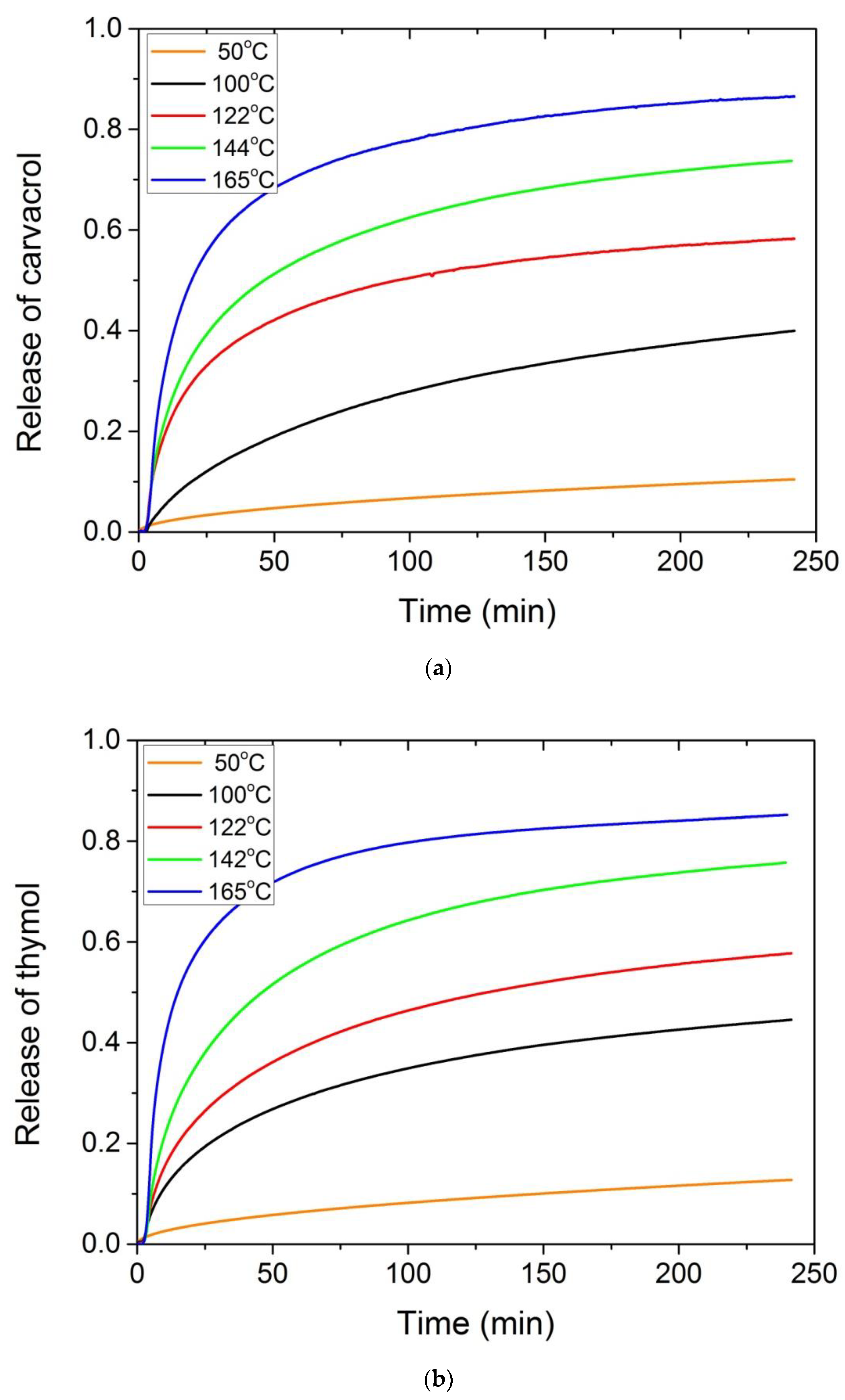
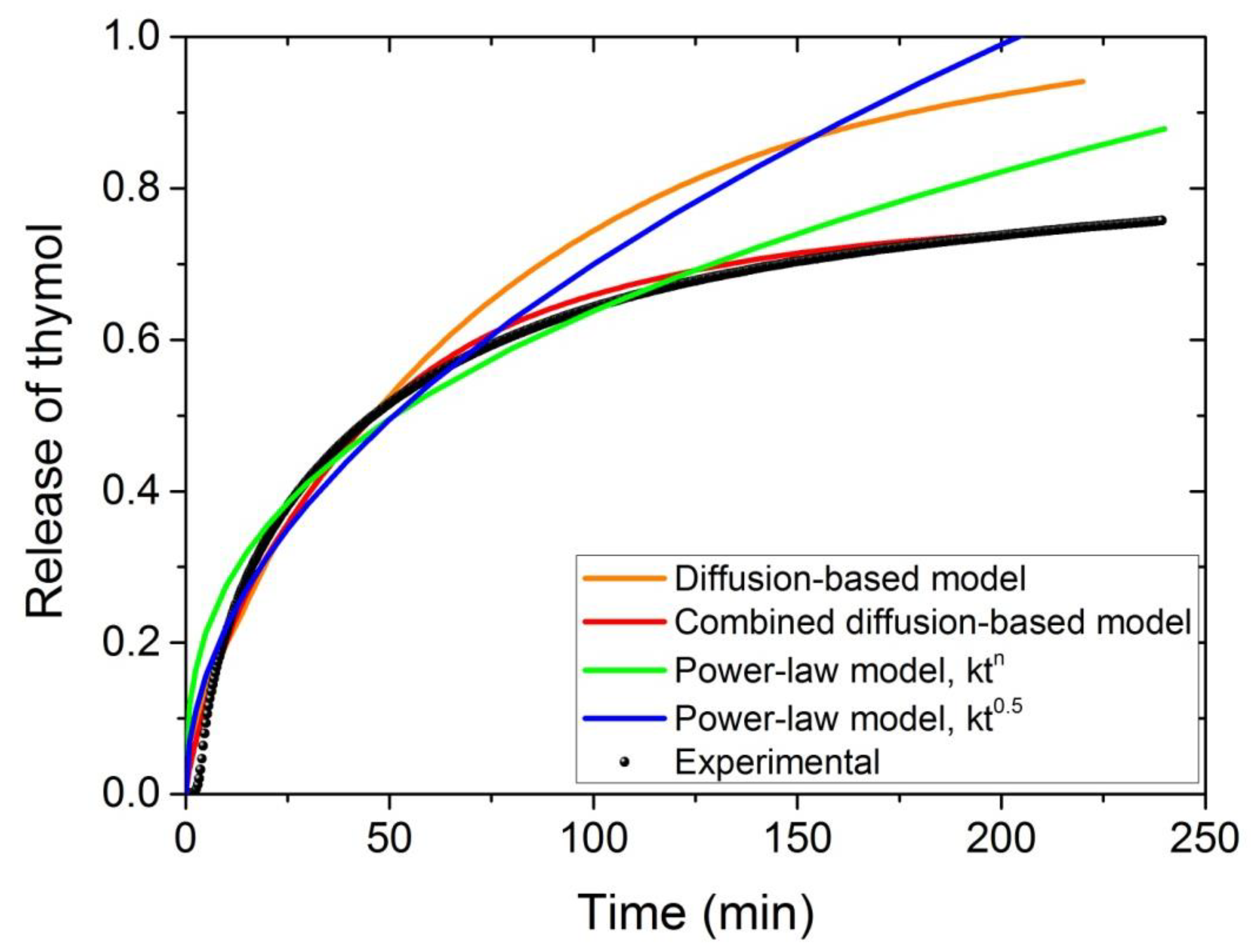

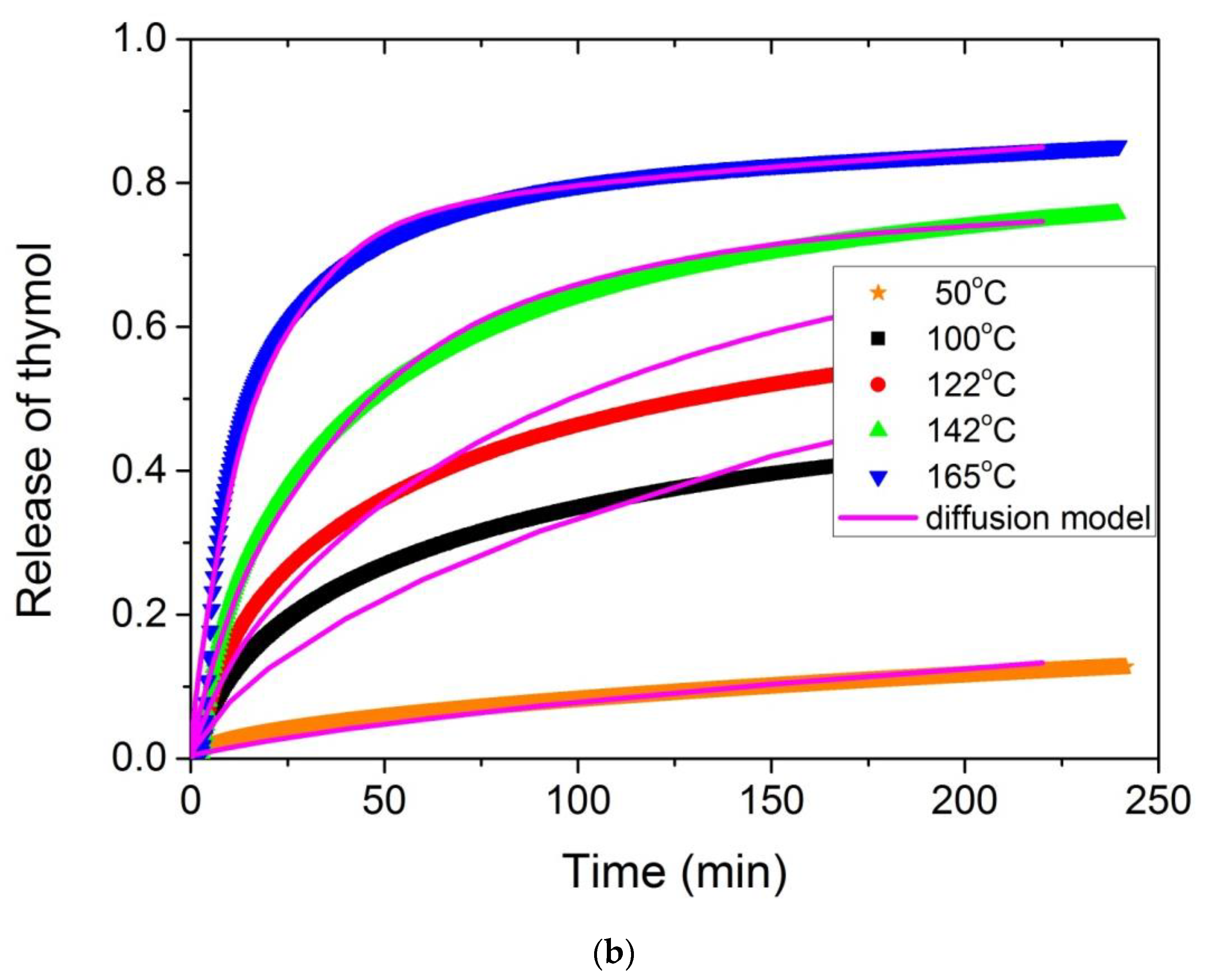
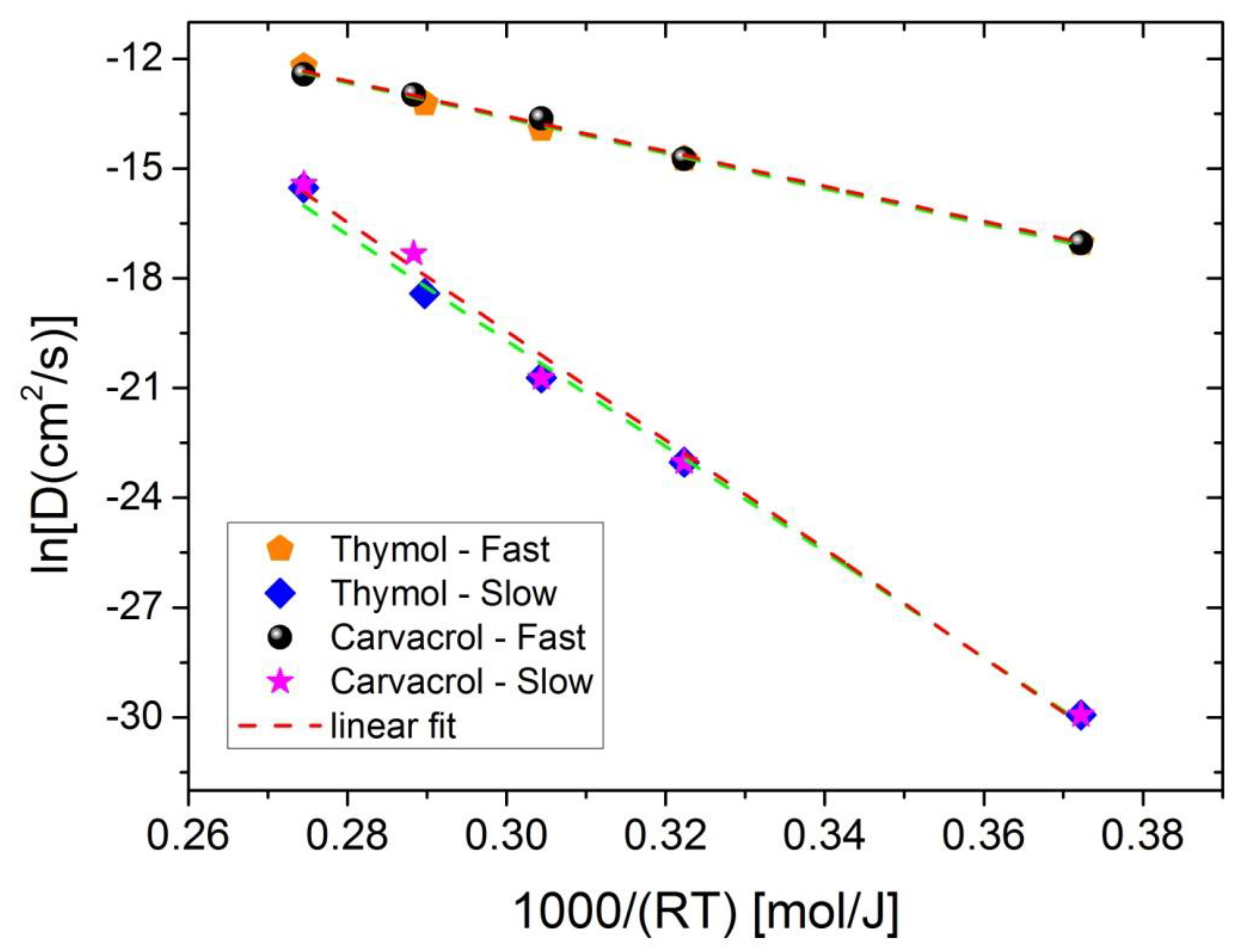
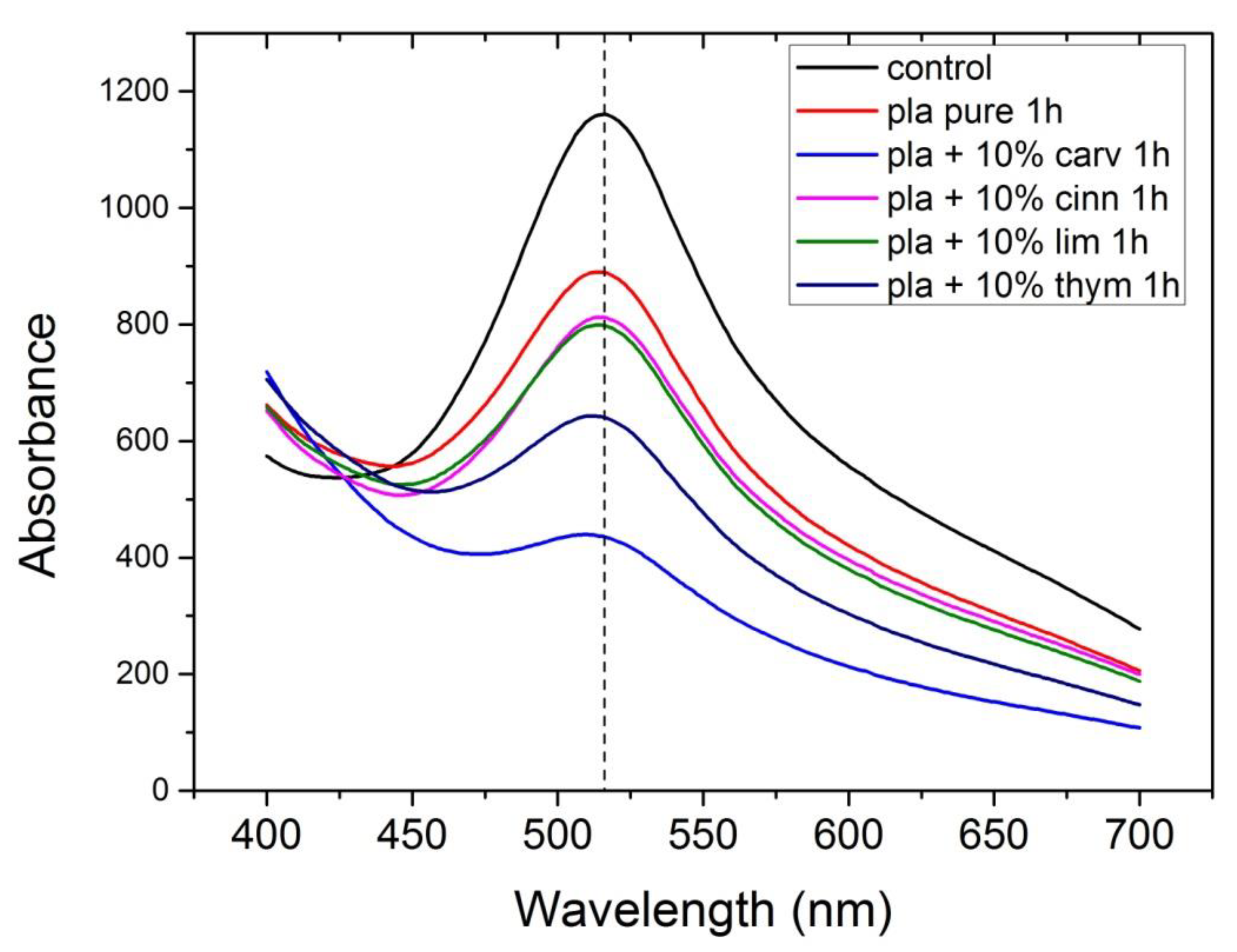
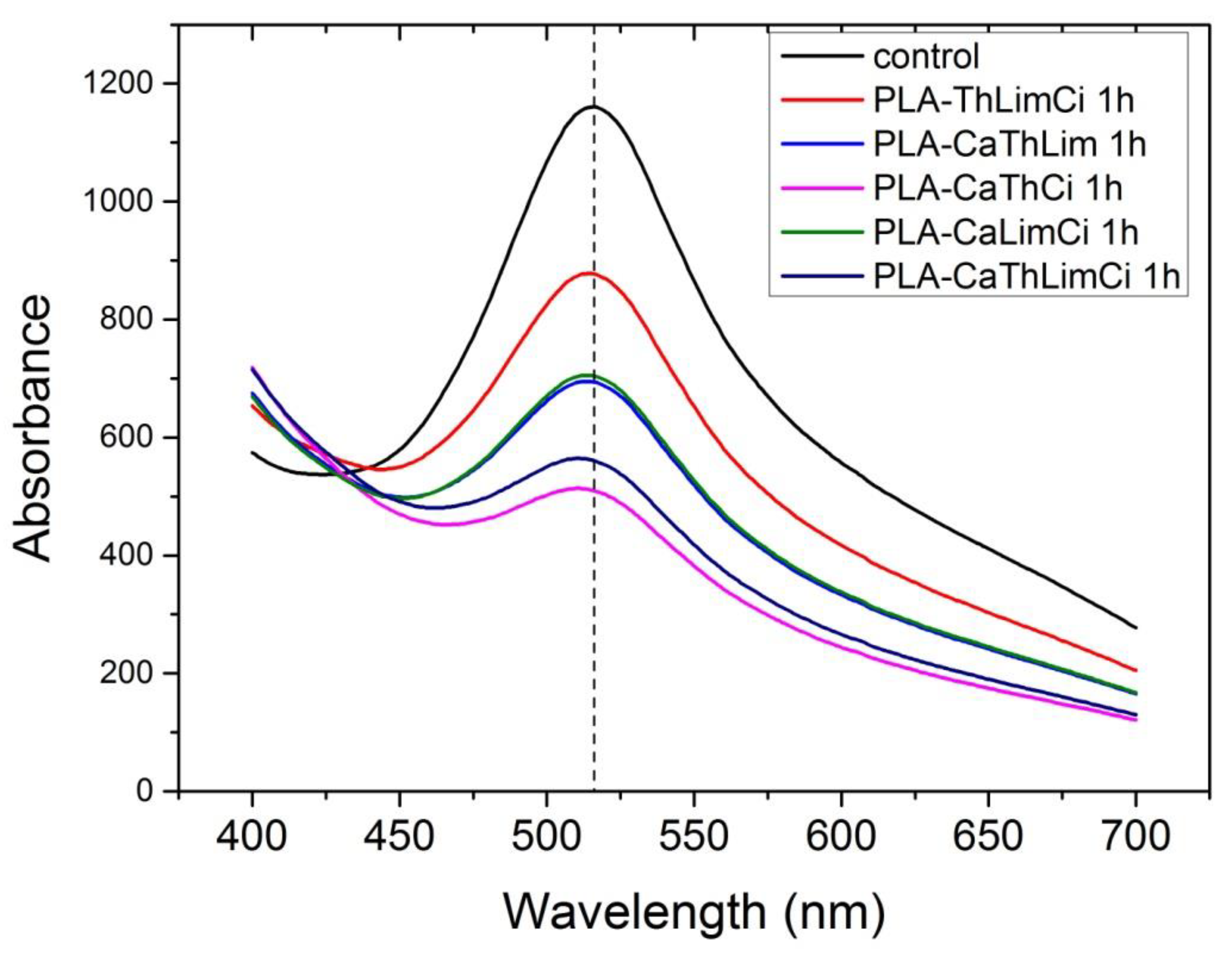
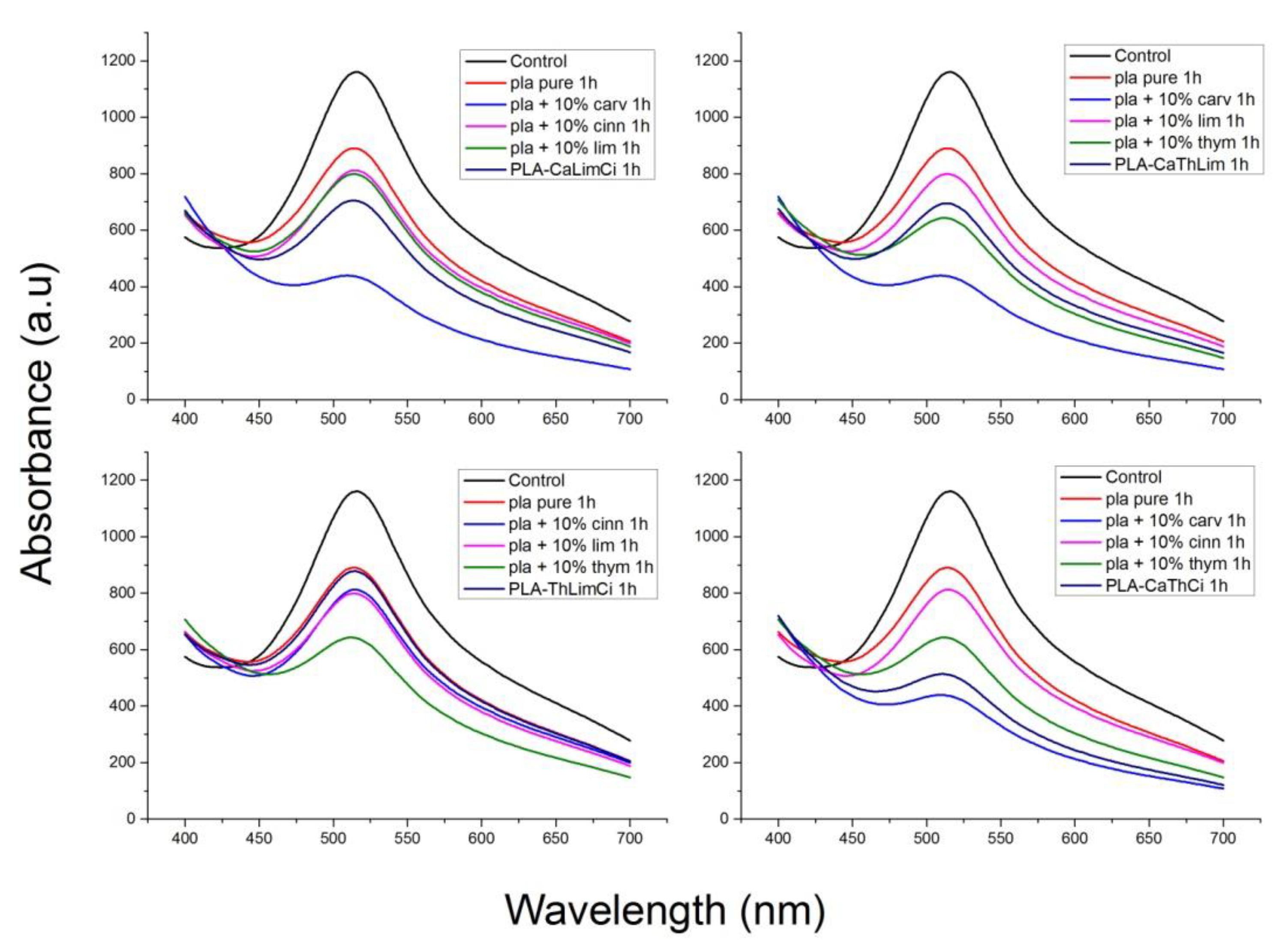


| Experiment # | Code | Thymol (wt%) | Carvacrol (wt%) | Limonene (wt%) | Cinnamaldehyde (wt%) |
|---|---|---|---|---|---|
| 1 | PLA | 0 | 0 | 0 | 0 |
| 2 | PLA-5Th | 5 | 0 | 0 | 0 |
| 3 | PLA-10Th | 10 | 0 | 0 | 0 |
| 4 | PLA-5Ca | 0 | 5 | 0 | 0 |
| 5 | PLA-10Ca | 0 | 10 | 0 | 0 |
| 6 | PLA-5Lim | 0 | 0 | 5 | 0 |
| 7 | PLA-10Lim | 0 | 0 | 10 | 0 |
| 8 | PLA-5Ci | 0 | 0 | 0 | 5 |
| 9 | PLA-10Ci | 0 | 0 | 0 | 10 |
| 10 | PLA-ThCaLim | 3.33 | 3.33 | 3.33 | 0 |
| 11 | PLA-ThCaCi | 3.33 | 3.33 | 0 | 3.33 |
| 12 | PLA-ThLimCi | 3.33 | 0 | 3.33 | 3.33 |
| 13 | PLA-CaLimCi | 0 | 3.33 | 3.33 | 3.33 |
| 14 | PLA-ThCaLimCi | 2.5 | 2.5 | 2.5 | 2.5 |
| Code | Preparation Method | Initial Loading of the Active Ingredient (wt%) | Loading Capacity (wt%) | Encapsulation Efficiency (%) |
|---|---|---|---|---|
| PLA | 0 | n.d. | 0 | |
| PLA-5Th | Melt mixing | 5 | 3.6 ± 0.1 | 72 ± 3 |
| PLA-10Th | Melt mixing | 10 | 6.8 ± 0.2 | 68 ± 2 |
| PLA-5Th | Solution casting | 5 | 4.9 ± 0.1 | 98 ± 2 |
| PLA-10Th | Solution casting | 10 | 9.5 ± 0.2 | 95 ± 2 |
| PLA-5Ca | Solution casting | 5 | 4.8 ± 0.1 | 97 ± 3 |
| PLA-10Ca | Solution casting | 10 | 9.6 ± 0.2 | 96 ± 2 |
| PLA-5Lim | Solution casting | 5 | 4.6 ± 0.1 | 92 ± 2 |
| PLA-10Lim | Solution casting | 10 | 9.0 ± 0.3 | 90 ± 3 |
| PLA-5Ci | Solution casting | 5 | 4.7 ± 0.2 | 94 ± 4 |
| PLA-10Ci | Solution casting | 10 | 9.7 ± 0.1 | 97 ± 1 |
| Material | Tg (°C) | ΔCp (J/g·°C) | Tm1 (°C) | Tm2 (°C) | Tcc (°C) | ΔHcc (J/g) | ΔHf (J/g) | Xc (%) |
|---|---|---|---|---|---|---|---|---|
| PLA | 58.4 | 0.43 | 147.4 | 155.1 | 107.7 | 26.34 | 27.53 | 29.6 |
| PLA-10 Th | 56.6 | 0.30 | 146.8 | 154.4 | 109.1 | 23.93 | 25.16 | 29.7 |
| PLA-10 Ca | 55.1 | 0.43 | 148.1 | 154.5 | 111.4 | 24.34 | 25.28 | 30.0 |
| PLA-10 Lim | 54.8 | 0.33 | 147.5 | 153.7 | 111.3 | 23.74 | 24.94 | 29.5 |
| PLA-10 Ci | 50.0 | 140.4 | 150.1 | 103.0 | 23.72 | 24.68 | 29.2 | |
| PLA-ThCaLim | 56.2 | 0.24 | 146.5 | 154.2 | 107.5 | |||
| PLA-ThCaCi | 52.3 | 0.34 | 146.7 | 152.0 | 104.9 | |||
| PLA-ThLimCi | 49.5 | 0.58 | 147.5 | -- | 111.3 | |||
| PLA-CaLimCi | 54.2 | 0.54 | 147.0 | 152.8 | 109.0 | |||
| PLA-ThCaLimCi | 49.4 | 0.34 | 145.6 | -- | 107.4 |
| Thymol | Carvacrol | |||||||
|---|---|---|---|---|---|---|---|---|
| Temperature (°C) | Df (10−6 cm2/s) | Ds (cm2/s) | f | R2 | Df (10−6 cm2/s) | Ds (cm2/s) | f | R2 |
| 50 | 0.04 | 10−13 | 0.72 | 0.997 | 0.04 | 10−13 | 0.60 | 0.988 |
| 100 | 0.4 | 10−10 | 0.72 | 0.948 | 0.4 | 10−10 | 0.60 | 0.968 |
| 122 | 0.9 | 10−9 | 0.72 | 0.939 | 1.2 | 10−9 | 0.60 | 0.962 |
| 142 * | 1.8 | 10−8 | 0.73 | 0.991 | 2.3 | 3 × 10−8 | 0.68 | 0.986 |
| 165 | 5.0 | 1.8 × 10−7 | 0.72 | 0.992 | 4.0 | 2 × 10−7 | 0.72 | 0.989 |
| Ln (D0(cm2/s)) | Ea (kJ/mol) | R2 | |
|---|---|---|---|
| Carvacrol | |||
| Fast | 0.805 ± 0.162 | 47.9 ± 1.5 | 0.9962 |
| Slow | 25.20 ± 2.03 | 148.8 ± 6.5 | 0.9925 |
| Thymol | |||
| Fast | 0.866 ± 0.582 | 48.2 ± 1.8 | 0.9941 |
| Slow | 23.63 ± 1.67 | 144.4 ± 5.3 | 0.9946 |
Publisher’s Note: MDPI stays neutral with regard to jurisdictional claims in published maps and institutional affiliations. |
© 2021 by the authors. Licensee MDPI, Basel, Switzerland. This article is an open access article distributed under the terms and conditions of the Creative Commons Attribution (CC BY) license (https://creativecommons.org/licenses/by/4.0/).
Share and Cite
Siddiqui, M.N.; Redhwi, H.H.; Tsagkalias, I.; Vouvoudi, E.C.; Achilias, D.S. Development of Bio-Composites with Enhanced Antioxidant Activity Based on Poly(lactic acid) with Thymol, Carvacrol, Limonene, or Cinnamaldehyde for Active Food Packaging. Polymers 2021, 13, 3652. https://doi.org/10.3390/polym13213652
Siddiqui MN, Redhwi HH, Tsagkalias I, Vouvoudi EC, Achilias DS. Development of Bio-Composites with Enhanced Antioxidant Activity Based on Poly(lactic acid) with Thymol, Carvacrol, Limonene, or Cinnamaldehyde for Active Food Packaging. Polymers. 2021; 13(21):3652. https://doi.org/10.3390/polym13213652
Chicago/Turabian StyleSiddiqui, Mohammad Nahid, Halim Hamid Redhwi, Ioannis Tsagkalias, Evangelia C. Vouvoudi, and Dimitris S. Achilias. 2021. "Development of Bio-Composites with Enhanced Antioxidant Activity Based on Poly(lactic acid) with Thymol, Carvacrol, Limonene, or Cinnamaldehyde for Active Food Packaging" Polymers 13, no. 21: 3652. https://doi.org/10.3390/polym13213652
APA StyleSiddiqui, M. N., Redhwi, H. H., Tsagkalias, I., Vouvoudi, E. C., & Achilias, D. S. (2021). Development of Bio-Composites with Enhanced Antioxidant Activity Based on Poly(lactic acid) with Thymol, Carvacrol, Limonene, or Cinnamaldehyde for Active Food Packaging. Polymers, 13(21), 3652. https://doi.org/10.3390/polym13213652








